As the owner of ProModeler I get asked about servos a lot, perhaps none more so than for the class of aircraft typified by Extreme Flight's super popular 60-inch wingspan 3D-oriented models (and competing brands, of course).
This class of model is super popular because of their handy size, good handling, and economical 6S power system. Basically, you get astonishing performance because of three things; ultra light weight, huge control surfaces, and the incredible thrust derived by turning a 16" prop. And as it happens, which servos you select along with how you power them may materially affect your experience - no kidding!
Let's delve into the how-to involving servo selection to help guide you (useful information regardless of whether your intent is to fly it through really aggressive 3D-maneuvers, or not, and even if your allegiance is to another brand of servo). Note; the following question's often asked over the phone, or via email, and once via snail mail with a handwritten letter, but always comes across something like this;
I’ve been searching for a high-quality servo set for my next plane, yours definitely stand out. I’m not a competition pilot, just do this as a hobby, but as an engineer I value quality. Simply said; I don’t 'need' the best stuff but I love knowing I 'have' it . . . if that makes any sense. And as with everything Internet, everything is good and bad.
I’m planning to get something like Extreme Flight's 60” Slick, am learning 3D but doubt I'll ever get to the level of many out there. Can you give me some advice on how best to plan this next plane using ProModeler servos? Also, I see recommendations on running a BEC, of which I like the idea . . . any info on that you can share?
Thanks in advance for the help and advice.
. . . and my response invariably goes along the lines of this; 60" models call for mini-size servos, of which we have several suitable candidates. How do you fly, what's your budget, and how do you intend to power the avionics?


In short, we make available for your consideration several minis. These include our economical DS110CLHV and DS160CLHV (the ones in red featuring lightweight hybrid aluminum/polymer cases), plus our bespoke hand-assembled all-alloy case brushless motor equipped DS205BLHV and our range topping (power-wise) DS355CLHV super mini - yes a 355oz-in mini!
Note; the later is perfectly suitable of being used within significantly larger models (for example, I've got a set installed for testing purposes in an 89" Extra 260 by PAU that's just south of 19lbs). So don't be boxed into not opting for the DS355 servos just because someone tells you they're overkill for even the most aggressive pilots of 60" class aircraft because they're available for a reason. The point being, it's precisely because servos are often repurposed into altogether different models later, e.g. jets or helicopters that we offer such an astonishing mini. Added to which, because they're expensive (and thus, rightly viewed as an investment), nobody should judge what you install them in today because nobody can predict what the future holds!
Anyway, and in consideration of our handy M2S adapter (which we make expressly for using minis fitted within standard-size servo openings), we also believe this 355oz-in min servo may be a great choice for pilots of larger models also, e.g. 74" aircraft. And certainly worth serious consideration because you end up (including the adapter) at about 47g vs. 75g (important for aggressive pilots who obsess about weight).
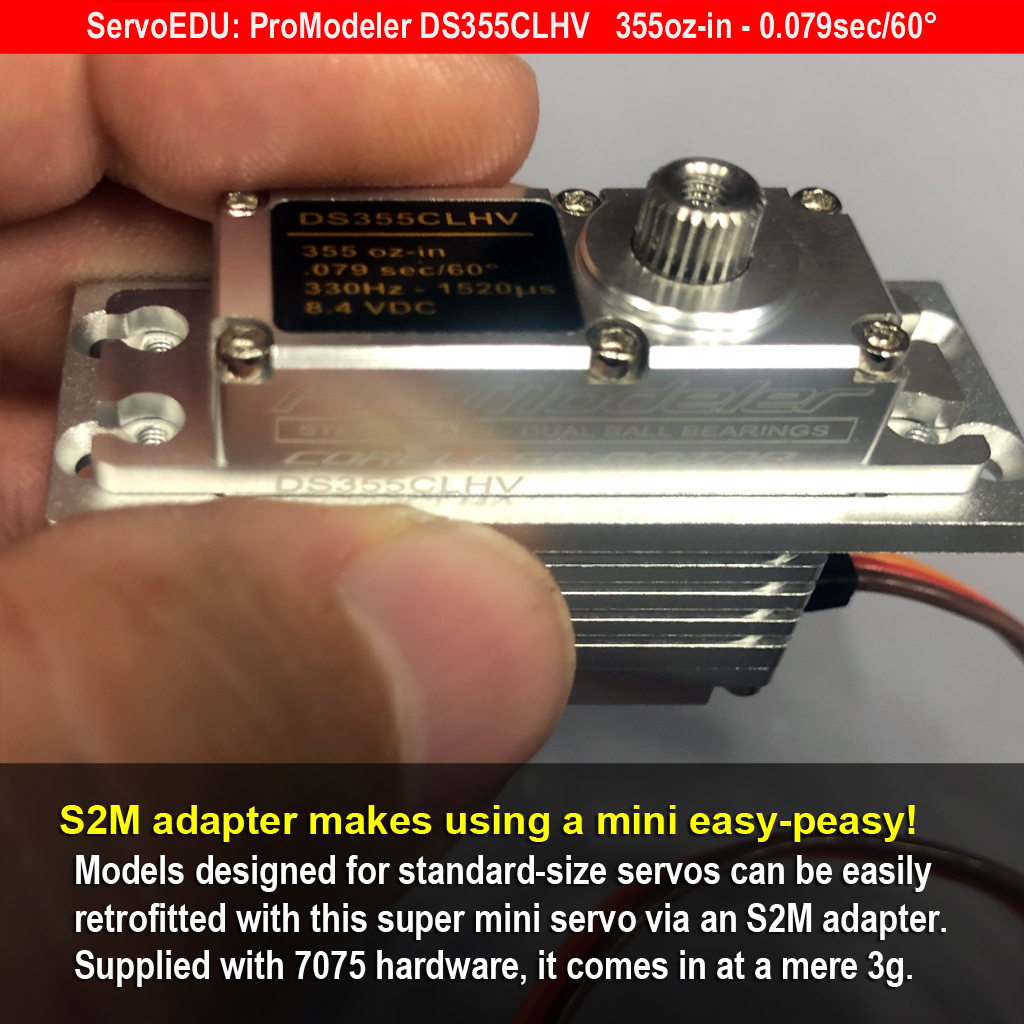

Note; before we continue, let me share what these confusing model numbers mean because there's no secret code. Decipher ours like this;
- DS = Digital Servo (versus analog)
- 160 = torque in oz-in (ounce-rating at 1" from the center of rotation)
- CL = coreless motor (DL=3-pole iron core, and BL=brushless)
- HV = High Voltage (up to 8.4V but they work down to 4.8V)

Power - two mechanical factors; torque and speed
Most folks selecting servos for a 60" span model opt for either our popular DS110 or our equally popular DS160. The principal difference is torque and speed (with the DS110 being a shade faster and the DS160 being nearly 50% more powerful). Does it matter? Sure it does . . . or we wouldn't offer both! And note; price probably plays a role but if performance were subpar, price wouldn't matter. The real question is; does the difference in power and speed matter to you? Does it affect the experience and the pleasure you'll derive from flying your model? Continue reading and I'll try to shed some light on this.
To recap, two of our servos, the DS110 and DS160 are the first choice of maybe 3/4 of pilots entrusting their 60-class 3D-aircraft to ProModeler. And note; these are the same servos I often use in my own planes (of which I have several by Extreme Flight). Of the two; I have a tendency to prefer the added torque of the DS160 because it has the power to horse a model through a botched maneuver. So for me, power is more important than speed because I am 'not' a top-class pilot.
However, it's also worth noting regarding the speedy DS110, a more competent pilot would never have gotten in trouble in the first place! Thus, this is a basic difference in my view - pilot competence. And it comes full circle because the more competent the pilot, then the more torque he wants, e.g. just to be able to perform some of the super aggressive maneuvers! Get it? There's no right answer! Anyway, there's a small increase in price for the DS160 versus the DS110, but it's modest.
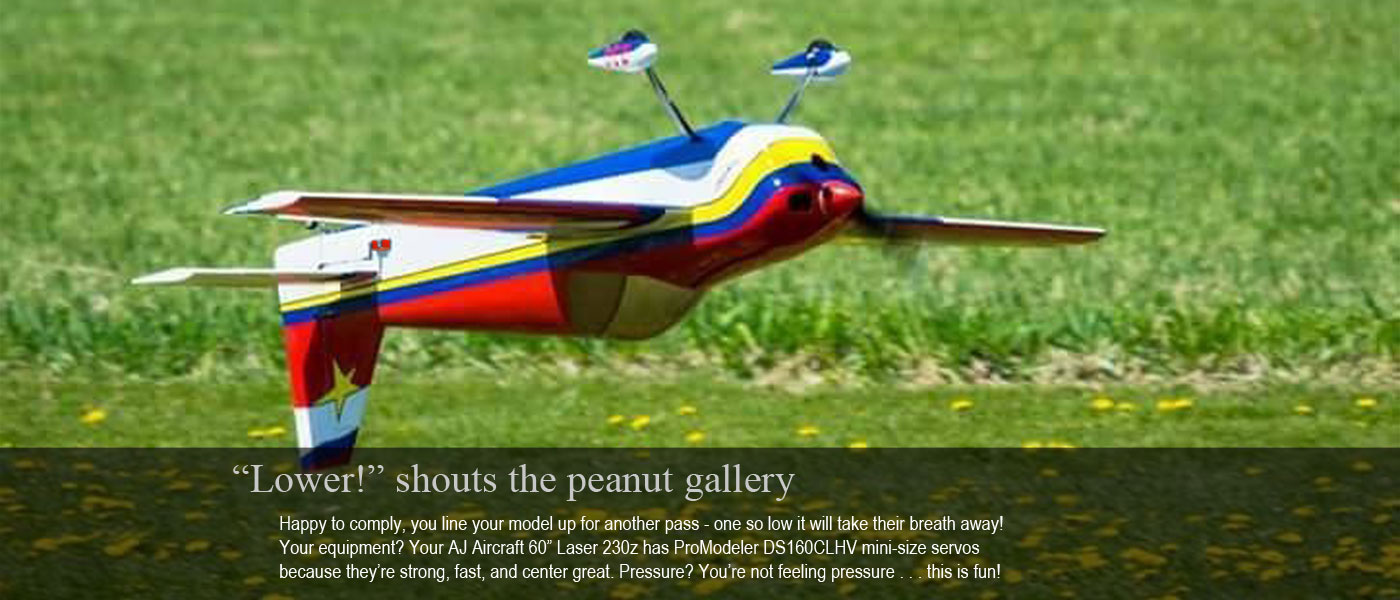

Regarding 3D-oriented model airplanes, one glimpse of elevator surfaces comprising 2/3 of the total horizontal surface area, or ailerons approaching 40% of the wing's area, and it's immediately obvious these aircraft are principally designed for über aggressive 3D-maneuvers. E.g. waterfalls, pop-tops, terminators, rifle rolls, and the like versus relatively sedate aerobatic maneuvers like loops, rolls, stall turns, and spins. With regard to your experience (what you experience as opposed 'to' your experience), more power is always a good thing because the added power permits maneuvers that are impossible with a less powerful servo, rifle rolls, for example.
In fact, it's due to the extreme maneuvers that some pilots opt for our super sweet DS205BLHV minis, instead of the DS160CLHV - just because it's got 25% more power. Note; sporting an all-alloy case and brushless motor, these are very, very good servos but you pay dearly for the privilege. Thus, the question is, do you 'need' them? You probably don't - but - maybe you just want them! Nothing wrong with that.
Also, and built similarly, our DS355CLHV is a beast, and it's also a mini. And just take a gander at the gear train of our DS355CLHV to see the obvious quality in every aspect of its construction! Eyeball the little details, like the bushed-case where we press bronze into the pockets for the gear shafts We do this because what use is high performance if it won't last a long time?
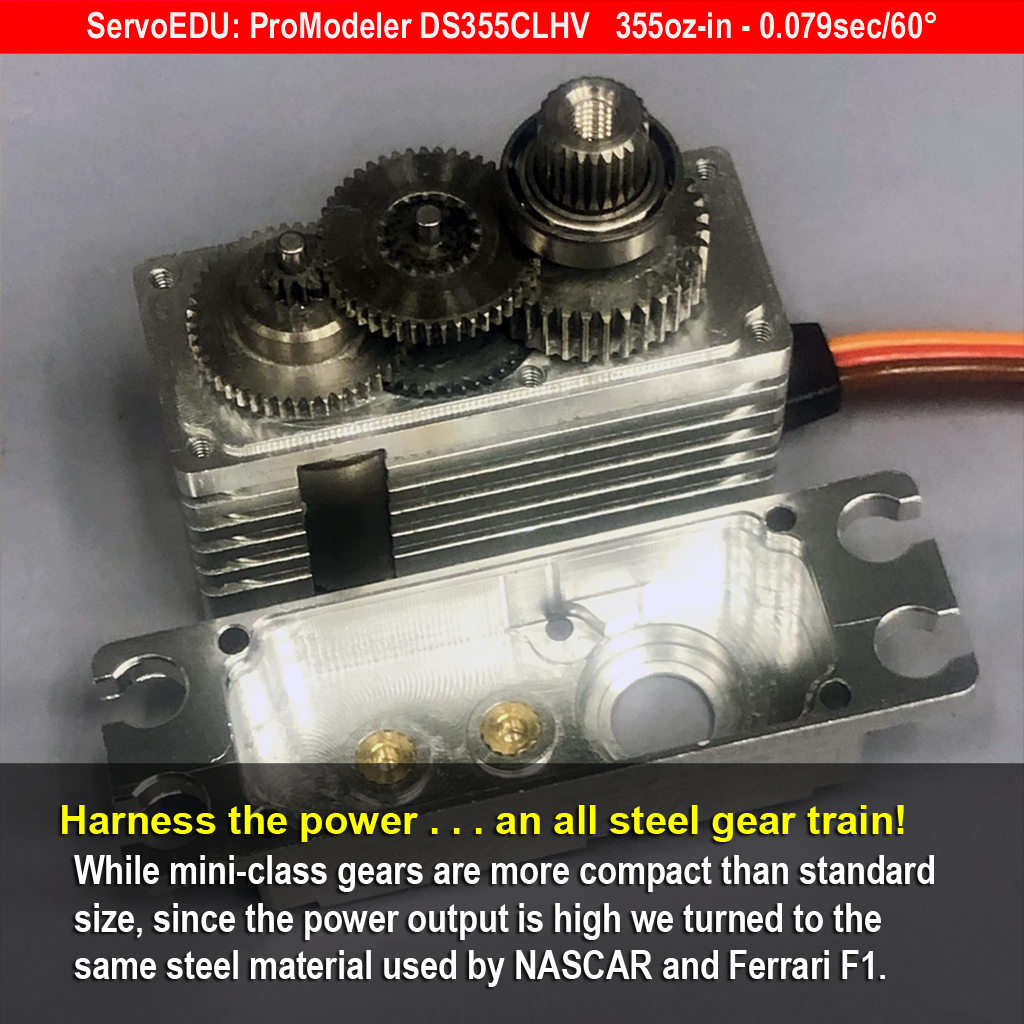

Back to yakking about maneuvers; the 3D-type are for very aggressive pilots while the latter are the domain of traditional sportsman, or club-pilot type (as well as pattern and IMAC-type competitors). Doesn't mean these 3D optimized aircraft won't do mere loops and rolls, but instead it means they're finely tuned to deliver the insane performance-maneuvers we call 3D-type. The company bills itself as Extreme Flight for a reason!
Moreover, while the former type of maneuvers are performed in some semi-successful fashion by nearly all first year pilots (once they transition from a trainer to a sport model), the latter (3D) require dedication and desire. It's like old Yamaha TV commercial whose tag line was, 'Different strokes for different folks!', where some pilots are more drawn to the super aggressive forms of flight.
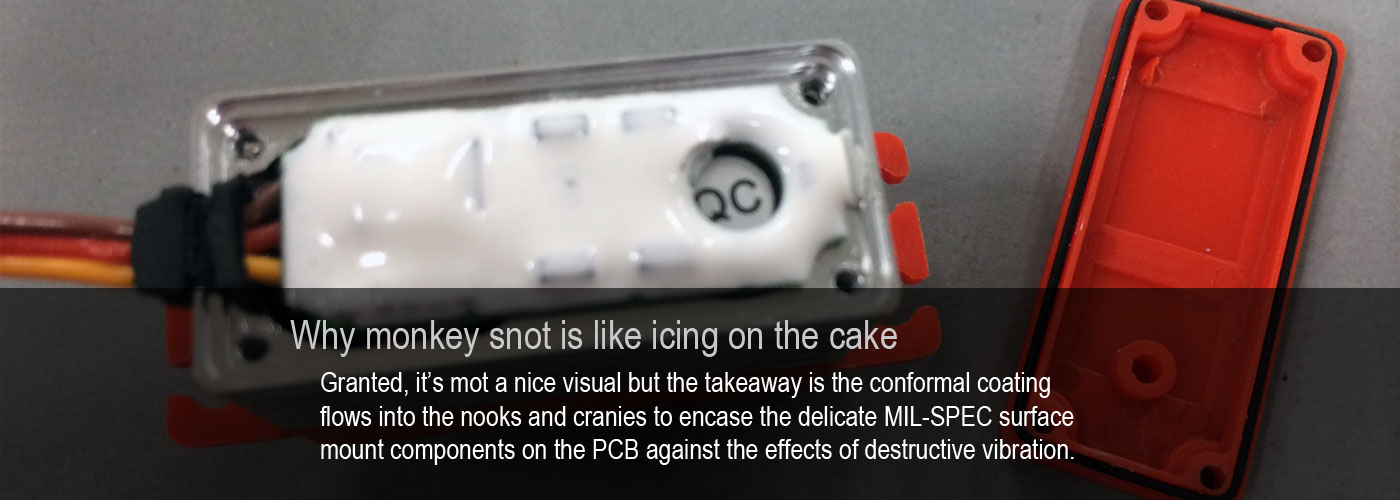

Unsurprisingly, the servo requirements for the former class of maneuvers are quite different than for 3D (because of their sheer violence and speed) like why for a sporting driver, a typical family 4-door isn't best for slalom! Basically, for 3D-maneuvers, the servo must move much larger control surfaces, do so much more quickly, and at the same time produce significantly greater physical power and speed in order to horse the model through the air by force!
Bottom line? Whether 110oz-in is enough for you, or you want 3X more, you're gonna have to pick your poison! But there's more than just torque and speed involved in the decision because there are also the electrical considerations. That's a different kind of power and it's what's up next!
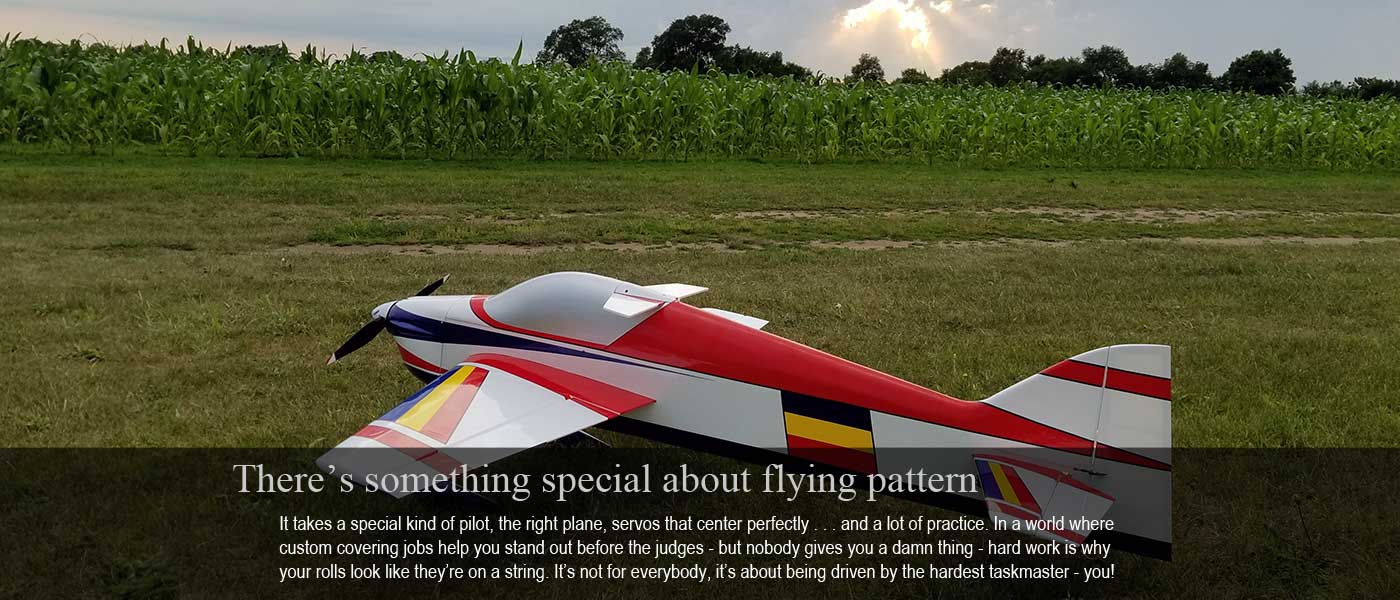

Power - two electrical factors; current and voltage
Another power consideration is electrical-power versus mechanical-power. This brings us to a critical question with regard to the BEC circuits, which guys often ask me about. E.g. where it's my opinion BECs are good until they're not. Meaning BEC-failure can cost you an airplane - yikes! But there's more than one kind of BEC failure.
Beyond the obvious, e.g. the BEC device itself failing, BEC-failure also includes the situation where it doesn't have the poop to run the servos. Not outright failure, but nevertheless failure of different kind because it couldn't do the job. Modelers are forever saying, I set it to 8V, is that enough? Basically, many don't seem to understand the role of current in what's going on. Discussion for another day. Anyway, another factor beyond the device itself crapping out is whether the BEC has the cojones to run powerful servos - in terms of current delivery. This is important!
Add to it, there's also a matter of how clean is that current - is it as good as a battery? Nope . . . not even close! Anyway, we disclose specs for all our servos in terms of torque and speed, and these specs are based on varying voltages. We expressly tell you the current requirements at each voltage level. There are no secrets with us. The specs are disclosed like this.
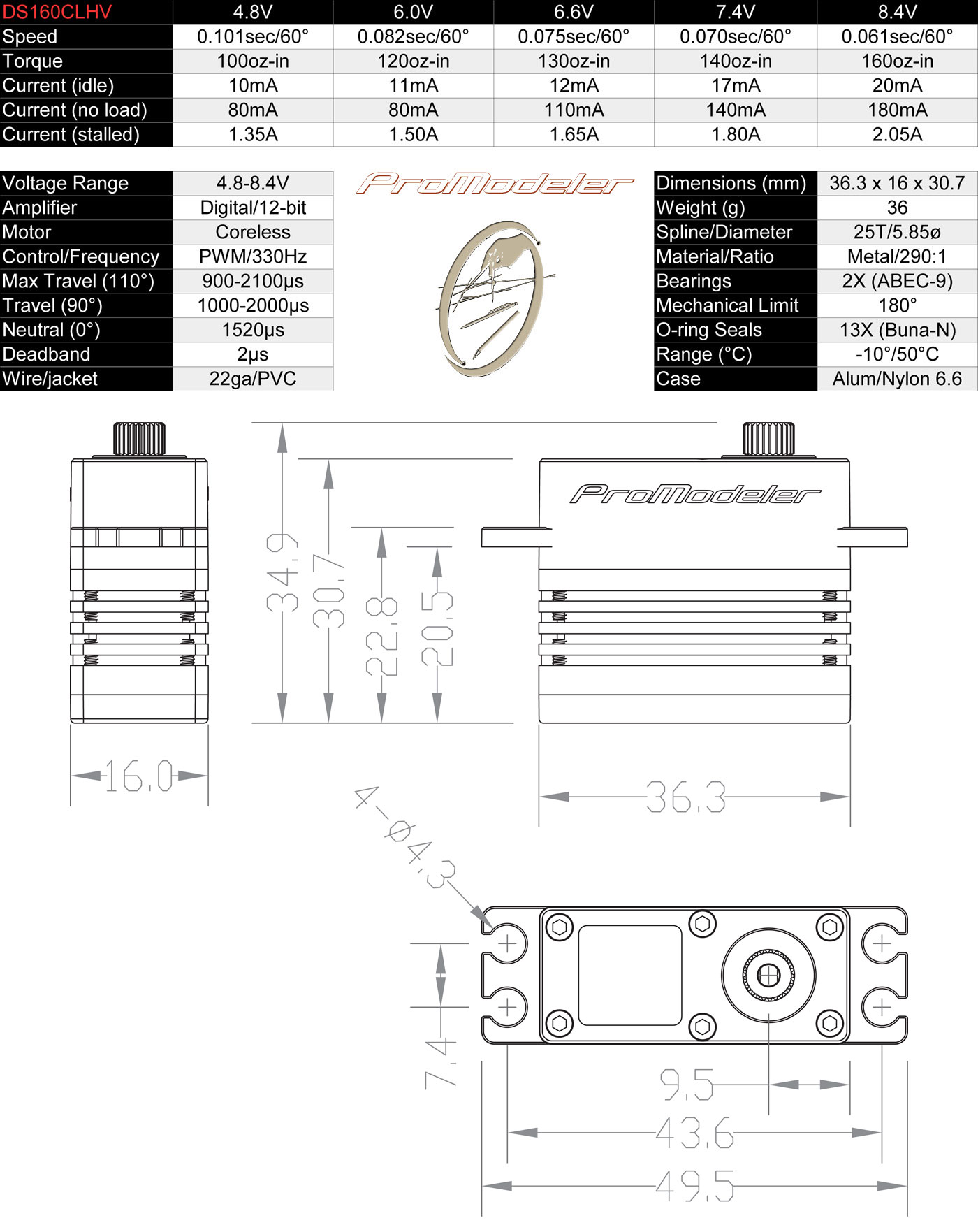

Thus, factors to consider beyond outright BEC-failure (principally due to the BEC circuit being more complex than a battery, e.g. more stuff to go wrong) include whether it's up to the job, e.g. can it deliver enough current. And note; if it's struggling to keep up then it's running closer to capacity meaning it's also getting hotter, which can also lead to premature failure. It's a vicious circle! And don't forget the ESC itself may go tits up because 3D-pilots abuse the crap out of them because of the tremendous current demands whilst flying. Thus, if the ESC takes a crap, then it takes the BEC along with it because the one unit is responsible for both the avionics-power along with propulsion-power! Put another way, using an ESC equipped with a BEC is putting all your eggs in one basket. Food for thought, eh?
After all, using a BEC for the convenience is one thing, but are proponents (the people selling these things) helping you account for all the potential costs? I mean beyond the price of a model, but to include the risk of injuring someone if things don't go as planned? This is why my advice is don't decide to use one as a simple matter of convenience is all I'm trying to say.
And delving deeper, why do I argue this position? Look back at the specs; high performance servos (ours, or another brand) and you'll see we're dealing with physics, not magic. Any high performance servo is going to demand a lot of current. Amounts of current the commodity brand oriental imports simply don't approach (there's no such thing as a free lunch and if a servo makes twice the power of the import, it's consuming electricity that simply has to come from somewhere). The point being, that freebie-BEC included with your ESC may have been fine with entry level servos but when you up your game with serious performance servos, e.g. when you get off the porch and run with the big dogs, then what was good enough once upon a time just may not be up to the task, now. More later, but basically, you have to evolve your thinking (when the facts change, the thoughtful change their minds instead of sticking by what they've always done). Look, I'm not kidding, some of our servos in the mini class are easily exceeding the power of servos used to win the TOC 15 years ago - 45lb models equipped with 200cc engines!

I've had a ton of servos over the years, and decided to try ProModeler. The bang for the buck is amazing. Fast servo, amazing centering, tons of torque. Built to last years, and price is also great for what you get!
-- Nick Ziegler, Moline, IL

Me? I'm well known for the disdain I have for BECs. Frankly, I prefer to carry the added weight (and deal with recharging) a separate 2S battery for powering the avionics. My reasons aren't too complex and have mostly to do with;
- the greater odds of BEC-failure due to higher component count, and
- the significantly greater power delivery of a battery versus a BEC, and
- the ease with which I can feed the receiver more current via battery.
On the flip side, a BEC is definitely easier to live with. And this is important to some because you only charge the propulsion-battery instead of also charging an avionics-battery. I get it because I'm as lazy as the next guy. As for the argument regarding the little bit of added weight, give me a break! We (and others) offer 2S packs weighing <20g. If you've somehow fooled yourself into believing you can discern differences in flight due to such an insignificant difference in weight (60" models go 2200-2500g), then quit reading because you're simply too smart for what we have to share in the way of knowledge and experience!
Let me be even more blunt . . . many, many modelers elect to use a BEC and regularly experience success (and while we're being blunt, we're sharing our opinion and dispensing free advice worth every penny you paid). We're telling you the facts whether you want to grok what the statistics say regarding higher component count and the electrical considerations of cleaner current delivery and what it implies for delicate control electronics, or not. We don't really care what you do because our servos function with BEC output and it's your model and your decision. But if you're wondering, and certainly if you asked, then we're going to share our opinion. Anyway, all I have to add is this - think carefully and decide wisely.
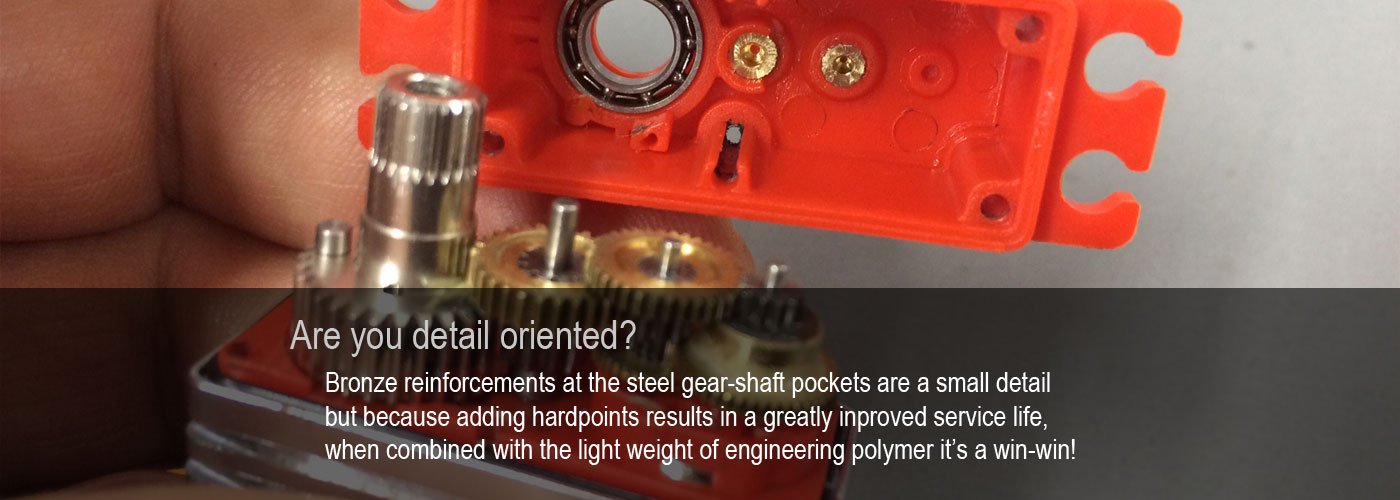

Me, as an engineer, I can't help but look at things like the component count and the consequences. For example, a 2S LiPo has two cells, three solder joints, and a lead . . . dead nuts simple. The BEC has more going on. In general, more complex is bad. Added to which, batteries fail gracefully over time (and each time I recharge I get an indication of how well the pack is doing) whilst electronic components tend to fail suddenly, like a light bulb - poof and done! So whether to use a BEC, or not, isn't an especially complex decision, but it's definitely an important one.
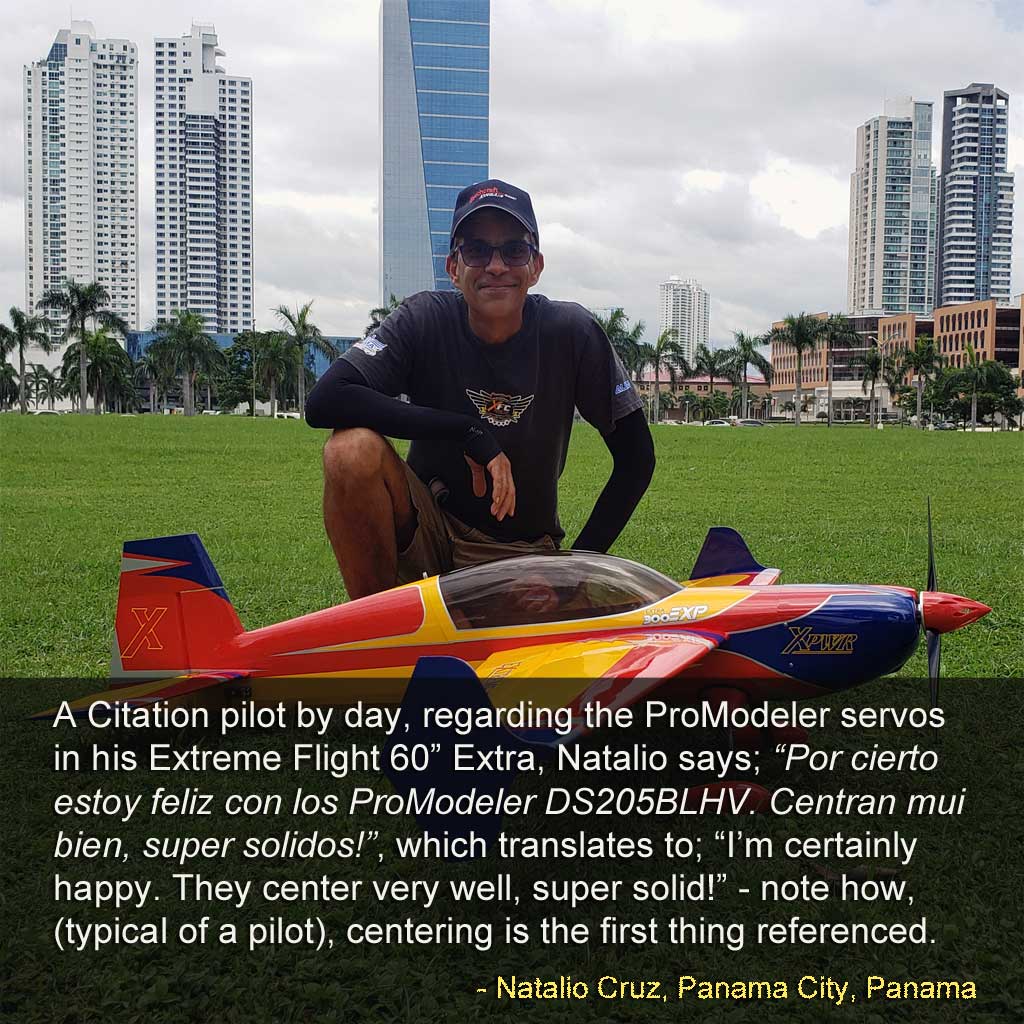

Summary:
Torque, speed, voltage, and current are the usual consideration for most servo-buyers. Price is also but accounting for the fact our servos are priced competitively with mass-market imports whilst being bespoke means it's less of a factor for any pilots save fan boys.
Anyway, of the four considerations, most guys (90%?) decide on the basis of the torque. Yup, believe it or not, torque is their sole consideration (well, many consider price, also). And that's OK but honestly, single-factor buyers usually aren't ProModeler-type guys. We're OK with it (as if we had any choice) because our focus is principally on the 10% of modelers sharing a more disciplined, thoughtful, and professional approach to the sport.
Since you're reading this it's pretty easy to know into which camp you fall. Basically, ProModeler customers consider torque and speed and centering and current draw and durability and resilience and quality and price because they can walk and chew gum. In short, a ProModeler customer isn't a single-issue buyer, but instead is pretty good at holding more than one thought in mind, e.g. juggling all factors required to make the decision of what's best for him . . . get the picture?
Servo speed - yes, it's important, of course - but honestly, everybody can't feel the differences in flight. For example, I couldn't if my life depended on it. In fact, the DS110CLHV was originally envisioned as a budget tail rotor servo (our no holds barred version is the DS95BLHV all-alloy brushless). How fast is the DS110? It's fast! Like faster than Maggie (my beady eyed pooch) making her getaway after stealing a hot dog off the table. I mean really fast!
Anyway, one day a savvy pilot called and asked me about using a DS110 for his 60" model (at the time we actually marketed it for helicopters because it never occurred to us there would be a fixed wing use, e.g. within the section devoted to tail rotor servos). I responded along the lines of, "Dunno, try it and see, let me know."
Sure enough, a couple weeks later he ordered three more, which pretty much told me all I needed to know. Especially considering I learned he was sponsored by another brand! So basically, out of sheer frustration because he was having issue with slop after 20-30 flights (I kid you not), decided to try ours. So he reached into his own pocket (remember, this despite being a sponsored pilot) and tried ours - yeehaw!
So things developed from there and as a consequence, now he flies nothing but ProModeler . . . and in case you're wondering, no, he's not sponsored because we don't sponsor anybody! This guy, a darned good 3D pilot by any measure, is buying his servos like everybody else - you could in fact say he's sponsored . . . by Mastercard!
Anyway, with a full complement of DS110 in his model, he made a video showing how well the model flew and how well they centered (centering is actually all he ever talks about). And he told his pals about them. Later, he shared about how well they held up (that was the point, remember?). Bottom line? Everything may be nice when it's new but how well do they hold up after 200 flights? That's what counts!
Meanwhile, less accomplished pilots (pilots like me), may find speed doesn't matter to them. That's right, it may not matter to them whether the model is equipped with DS110CLHV or DS160CLHV. And as I've explained, it's of little consequence to me because I can't really discern the difference in flight (yes, it pains me to admit this but there you have it). Meanwhile pilots who fly 3D a lot (versus talk about it) may indeed be able to discern the finer points about these two servos. But I know for certain many pilots can't tell the difference - I can't. Sad, but is what it is, which is why 'I' prefer one of our more powerful offerings. So in answer to which of our minis is best? Dunno, it depends!
Wrapping up the conversation regarding speed, your mileage may vary, yada, yada to which I'll add two things; first, don't pay for what you can't feel and second, to thine own self be true (meaning if you're never going to be a top pilot, then opt for torque over speed). And note; while you can have both, it's gonna cost you more.
Current considerations (amps) aren't really used in selecting servos other than by the most savvy. Modelers who pore of the specs page are the ones for whom we live - our name says it all. You are the ones who know exactly what the current demands are and the implications. Moreover, I don't have to tell you why a battery that's capable of delivering 30A is better for you than a BEC limited to 5 or 10A. In fact, you're probably only reading this to catch my mistakes!
And yes, I've totally neglected saying much of anything regarding voltage because 100% of servos (all brands) deliver better performance with higher voltage. Seriously, I really don't understand folks who buy high voltage servos but then operate them on SV (standard voltage, e.g. 4.8V or 6.0V). What's the point? Anyway, just remember this with regard to voltage; use the highest voltage you can 'and' don't forget, current delivery is all important.
Finally, everybody has a different perception regarding risk. Where I'm going with this is . . . if you opt for a BEC, just be aware of the servo's overall current requirements (measured in A), which we disclose in the specs for each servo at various voltages (as do all reputable manufacturers). The info isn't served up for no purpose, OK? Basically, ensure the BEC is capable of supplying enough amperage at whatever voltage (V) you select. Don't skimp!
Specifically to BECs, while I don't sell them, I'd recommend using an aftermarket accessory BEC from the likes of Castle Creations. This, versus relying on the freebie you get with the ESC (even when it's included with a CC ESC). Why? Simple; even if you don't anything about electronics, just compare the size of the two devices. This will help understand which is going to be more capable of handling the current better, e.g. the one where the BEC is included for free, or the stand-alone BEC-unit that definitely wasn't free! Save your stories for someone else, please.
But in all honestly, this is mostly just me preferring good quality stuff versus el cheapo and like opinions, everybody has their own standard. Seriously, there's no way the freebie BEC-circuit included with the ESC is anywhere near as good as the standalone purpose-made BEC. And lastly, if you insist on depending on a BEC, please don't rely on imported junk - can you tell I don't care about winning friends and influencing people? True dat because my intent is to put the hay down where the goats can get to it!
Finally, if it's not clear, I recommend using a separate avionics battery pack. Better still, use one equipped with two leads instead of one because it lets you input 10A to the receiver instead of 5A (and these, 2-lead batteries, we 'do' offer so it could be argued I actually do have a dog in the hunt even though there are dozens of battery suppliers).
Anyway, I hope this info doesn't further confuse things for you.
--
John
PS, further reading for the curious . . .
Bypassing the BEC:
On maxxing a servo's voltage:
The case against synthetic voltage: